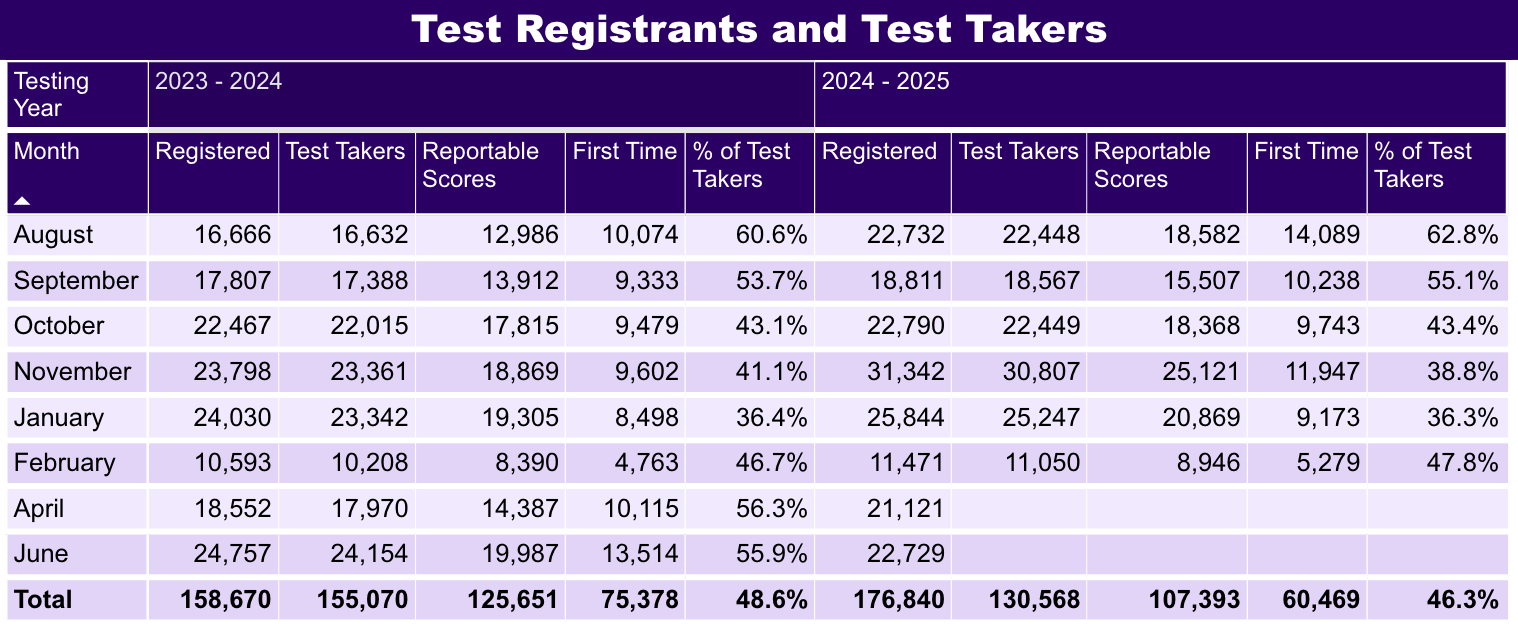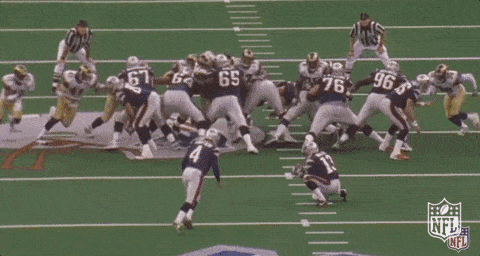With the middle of April here, the gale-force winds that many of us are experiencing are likely caused by the warming air patterns of spring interacting with the lingering cold weather systems of winter. Or maybe it’s because thousands of law school applicants, admitted students, and admissions officers are all collectively practicing their deep breathing techniques as April 15th comes and goes and the latest edition of the U.S. News & World Report rankings dropped and are still being digested … or maybe just spit out?
This has been one of those weeks when a lot of important moving pieces finally came together for the broader law school admissions community, so let’s take a moment to go through the usual numbers before we then dive into the headlines!
LSAT Registrations
Before stressing out this year’s applicants, let’s give a little blood pressure spike to next year’s applicants.
While it’s two weeks before we will have final numbers on the April LSAT, we’re just a week away from the registration deadline for the June LSAT. Per LSAC’s LSAT Registrants and Test Taker Volumes report, it’s going to be a doozy.

While we acknowledge that anything can happen in a week, we usually see the greatest surge in registrations happen in the days leading up to a test’s deadline. Our best guess is that the registration figures for the June LSAT will be around 33,000 when next week’s blog hits the digital newsstand.
For our readers applying to law school next year, the best predictor of “future law applicants” is “present LSAT test takers.” That’s especially true for the April and June exams since over 50% of the people who take those tests are doing so for the first time—those are the columns in the above chart that note “First Time” and “% of Test Takers.”
So our best advice for future applicants is to do your best with your LSAT prep, get a good night’s sleep before the exam, and then get cracking on your résumé, personal statement, and other law school application materials over the summer!
Deposit Deadlines
You know deposit deadlines are nigh when the Law School Admissions sub-Reddit is full of cycle recaps and asking internet strangers to assist you with your life decisions. And I write that with the utmost respect as someone who—on an average day—aspires to be a well-informed internet stranger!
We covered deposit deadlines in greater detail in last week’s post but it’s worth reiterating a few things and elaborating on a few others:
- First up: It’s going to be okay! It’s normal to be nervous when making a big life decision. But trust your process, remind yourself of all the things that are important to you for your law school experience and post-grad outcomes, and remember that you’re going to be a law student in the coming semester. This is a “YAY!” moment!
- But before the “YAY!” be sure to follow a school’s instructions for depositing. When in doubt for the exact timing of the deadline (Does “April 30” mean “by April 30”? Or “by the end of the business day on April 30”?), contact the admissions office. Don’t leave things in doubt.
- Additionally, give yourself some time to fill out your form and submit your deposit. Most schools’ forms are rather straightforward and many will autoload some of your personal information from your application. But the last thing you want to have happen is trying to fill out a deposit form in five minutes, only to discover that you need to find an ID number that the school emailed to you two months ago, and now your palms are sweating and your head is starting to tingle a little bit….
- Schools may allow you to pay your deposit via credit card, but some schools are still very much old school and will ask for checking account information. Have your banking information handy.
- And if you’re reading all of this and thinking “this sounds like something that would be inconvenient to do on my phone,” you are totally correct! It’ll be easier to hunt down an old email with an ID number if you’re trying to do this task on a laptop or CPU.
And with this first big wave of deposit deadlines hitting us, we’ll be consulting our tea leaves and Magic 8 Balls (i.e., r/LSA and lawschooldata.org’s Recent Decisions page) for waitlist activity starting soon.

The most telling signs will be if Redditors post messages about receiving outreach from schools regarding continued interest and/or admit offers being posted to lawschooldata.
U.S. News Rankings
And that brings us to the other big news of the week—the latest U.S. News & World Report law school rankings. You can find the entire list on USNWR’s website if you register with their site (ugh…), or you can take advantage of the kindness of the aforementioned internet strangers who were benevolent enough to post the entire list.
This year brought the biggest shakeup to the rankings in quite some time, perhaps since the very beginning of the rankings back in the 1980s.
- Harvard fell down to #6. Columbia is now at #10. The old standby rule was HYS (Harvard, Yale, and Stanford) at the top in come combination and then CCN (Chicago, Columbia, and NYU) right behind. The rule is long gone.
- Cornell dropped all the way out of the T14, down to a tie with UNC-Chapel Hill at 18.
- Texas, Vanderbilt, and Wash U all achieved their long-term dreams of cracking the T14 by the skin of their collective teeth (i.e., they’re all tied at 14).
And that’s before we go down into the 30s, 40s, and 50s where we begin to see schools moving by 10 or more places in the rankings.
While these were big shifts, the broader admissions community saw this coming. Pepperdine Law’s Dean Paul Caron’s TaxProf Blog published not only his predictions but also those of Spivey Consulting and Notre Dame Law professor Derek Muller. Scanning over their collective predictions, they were pretty close to the final product.
But while we follow such wonky blogs, we recognize that you—gentle reader—likely and hopefully do not. So what gives? Why the big fluctuations? Well, settle into your seat because explaining this fully requires going back in time to the fall of 2022.
This all began when a number of schools effectively threw up their collective hands and yelled, “ENOUGH!” The USNWR rankings historically relied on not only publicly available information vis-à-vis schools’ ABA 509 Reports but also a great deal of proprietary information. Gathering that private information took hours—if not days—of staff time at each law school. As Michigan Law Dean Mark West put it at the time:
“The staff time required to prepare our submission … comes at a cost—both financial and of opportunity—that no public institution should shoulder in the service of a revenue-generating third-party endeavor.”
After this first wave of law schools pointed out that the USNWR Emperor had no clothes, other schools noted other reasons to affirm its poor sartorial choices. Chief among those was how the rankings seemed to prefer Big Law employment outcomes over other types of jobs and downplayed public interest positions (including prestigious post-grad fellowships funded by law schools, which USNWR wouldn’t count at all as employment). A sizeable number of schools across the rankings range—from T14s on down the line—indicated that they would no longer provide the publication with any proprietary information.
In response, U.S. News changed their rankings formula to rely only on publicly available information—the ABA’s 509 Reports. They had to develop this new formula on the fly. While the rankings normally dropped in mid-March in previous years, USNWR pushed things back to mid-April 2023. And then when they published the preliminary rankings and statistics on their website, a number of law schools politely—but firmly—pointed out that USNWR had a number of errors in their data set. The publication pulled the rankings, issued a mea culpa, cleaned up their data, and issued the new new rankings in early May. USNWR has spent the past two years perfecting their updated formula, and this is the year we may be seeing the real end product of the process—while the publication may have been nervous two years ago to have Cornell drop out of the T14, they feel confident enough in their process to take that step now.
For our readers that came through that explanation unscathed and still reviewing this blog—we thank you! And we also offer a response to the question that you are no doubt asking yourself:
- How does this affect me and my law school decision?
And the answer is:
- It really shouldn’t.
Before talking about how any rankings process is ultimately futile, let’s first acknowledge the basic human instinct to organize and arrange. It’s also very normal to seek out expert knowledge to help inform decisions! The USNWR rankings offer a seemingly tidy way of organizing American law schools from top to bottom. But let’s now challenge things! USNWR’s rankings rely on a formula that they have created and that they typically tweak every year. In this formula, the peer assessment score (e.g., what law school deans think about each other) counts for 12.5% of the ranking, while the median LSAT for the incoming class counts for 5%, and library resources count for 2%. These weightings are completely arbitrary and subjective. As a future law student, the opinion that another law school’s dean has about your school hopefully has no bearing on your education unless this is a Mean Girls situation.

Your law school’s library probably has a greater daily effect on your education … but how do you evaluate a library? By the number of physical books (which are becoming less important as collections are digitized)? By the number of library staff? Back in the day, one statistic USNWR asked of every school was how many chairs and desks were in the library which would inevitably lead to some gamesmanship with building services on “chair counting day.”
Even the most straightforward rankings have their pratfalls. Take the world of sports, for example. Most American sports at the high school, collegiate, and professional levels culminate in some sort of postseason tournament. The winner of that tournament is deemed that season’s champion. But is “winning the championship” the same as “being the best team”? Dear reader, I can offer personal experience of cheering for teams that were clearly the best in the league that year … and suffered playoff heartbreak

and other times cheering for teams that had no business even being in the playoffs … and yet were crowned champions a few weeks later.

Life is funny like that.
So what should you make of these rankings and should you base your life decisions on their fluctuations?
- To the first part of that question, make of the rankings as you will, but we would encourage you not to treat them as gospel. USNWR can be useful as a way to aggregate schools into peer categories, but even that utility is passing by. For example, we are curious to see who next year’s applicants put in the “T14”—is Georgetown back in, is Cornell out, was Wash U’s invitation even real or was it just a mean prank? But remember that the things that USNWR takes into account may not be the things that are important to you … unless you truly care what other law school deans think about your school.
- And to the second part, we encourage law applicants to consider the things that are most important to them. Perhaps the most important thing is access to a particular geographic market for their post-grad job. In that case, schools located in that market will very likely have more grads working in that city or state regardless of each school’s ranking. Or maybe a student has a specific professional aspiration and a law school has a clinic in that exact field. Or another student wants to go into public interest work and decides to attend a law school based on a large scholarship offer. Determine the things that are most important to you and let that information guide your decision. Or as we put it in the previous section—trust your process! As long as you are making the best decision for yourself, you can’t go wrong!
7Sage Events
After a hiatus, our admissions classes are restarting! First up will be an AMA-style session on April 16th with one of our LSAT tutors and one of our admissions consultants. We’ll then have several “What Does My Score Mean” sessions at the end of the month when the April LSAT results come back. Registration is free but required.
Also, a reminder that you can check out our past sessions via our Class Library—just enter “Admissions” into the search bar.
The next episode of the 7Sage Admissions Podcast is coming on Monday and will feature a conversation with Pauline Syrnik—7Sage consultant and someone with lots of experience in the public interest and government sectors. She’ll be sharing her professional path and giving some tips for law students and applicants who may want to follow the public interest path. Be sure to tune in on Amazon, Spotify, Apple, or wherever you stream your podcasts!